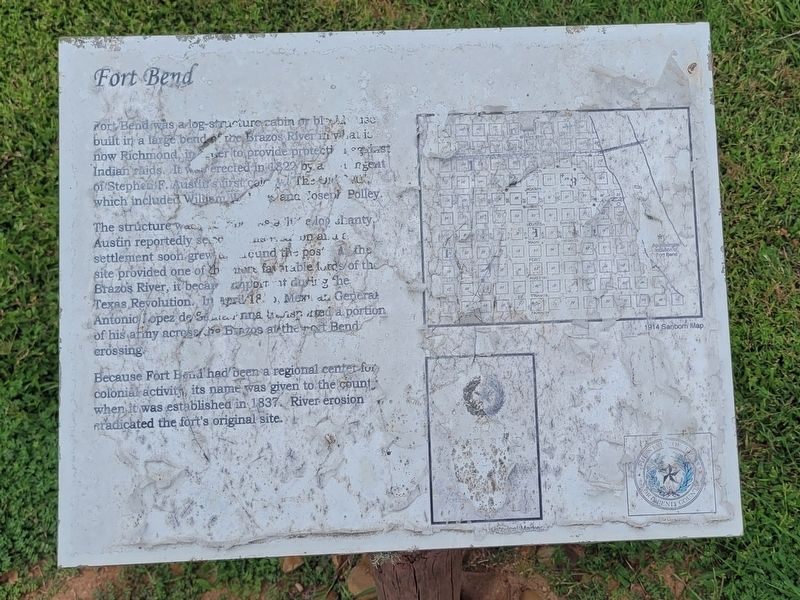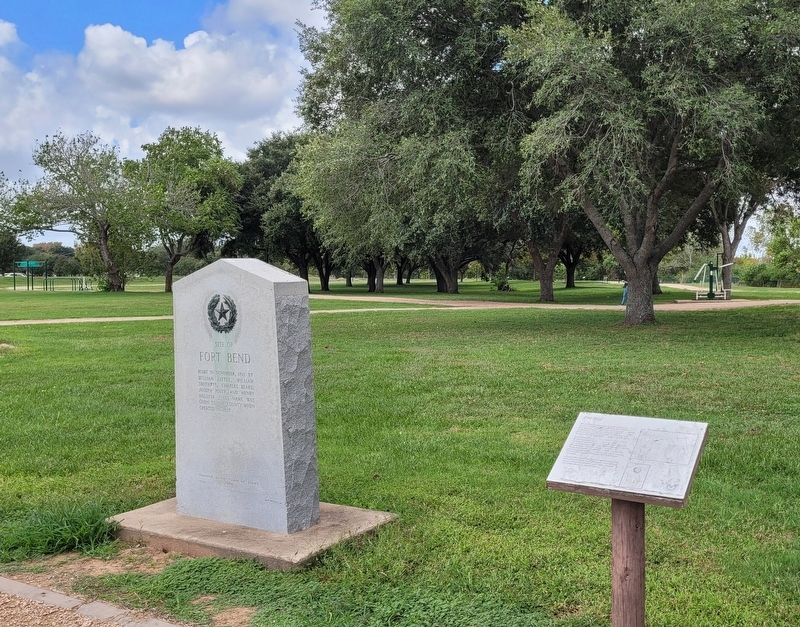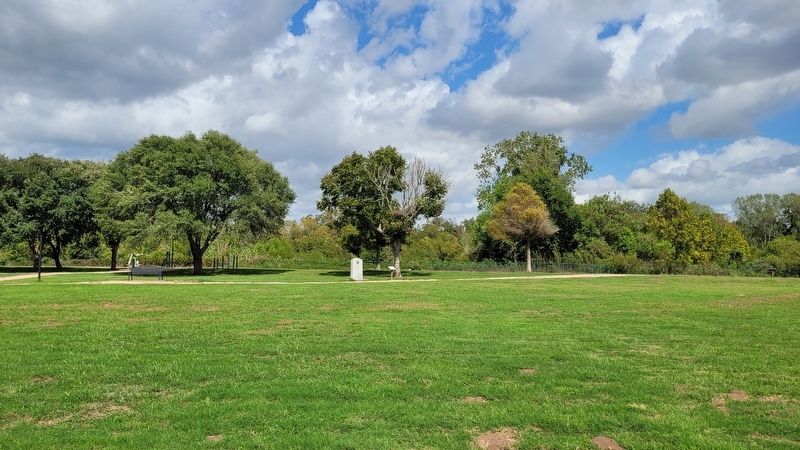Hillcrest Circle in Richmond in Fort Bend County, Texas — The American South (West South Central)
Fort Bend
The structure was described as a "little log shanty". Austin reportedly selected this site and a settlement soon grew up around the post. As the site provided one of the more favorable fords of the Brazos River, it became important during the Texas Revolution. In April 1836, Mexican General Antonio Lopez de Santa Anna transported a portion of his army across the Brazos at the Fort Bend crossing.
Because Fort Bend had been a regional center for colonial activity, its name was given to the county when it was established in 1837. River erosion eradicated the fort's original site.
Erected by Fort Bend County.
Topics. This historical marker is listed in these topic lists: Forts and Castles • Settlements & Settlers. A significant historical date for this entry is April 18, 1822.
Location. 29° 34.637′ N, 95° 45.106′ W. Marker is in Richmond, Texas, in Fort Bend County. It is in Hillcrest Circle. Marker can be reached from Eugene Heimann Circle , 0.1 miles east of Richmond Parkway. The marker is located in the central section of the Mirabeau B. Lamar Homestead Park and Archaeological Reserve. Touch for map. Marker is in this post office area: Richmond TX 77469, United States of America. Touch for directions.
Other nearby markers. At least 8 other markers are within walking distance of this marker. Site of Fort Bend (here, next to this marker); Pioneer Artifacts (within shouting distance of this marker); Mirabeau B. Lamar (within shouting distance of this marker); Agriculture (within shouting distance of this marker); Fort Bend County (within shouting distance of this marker); Lamar's Last Years in Richmond (within shouting distance of this marker); The Lamar Slaves (about 300 feet away, measured in a direct line); Natural tributes of the Site (about 300 feet away). Touch for a list and map of all markers in Richmond.
Also see . . .
1. Fort Bend. Texas State Historical Association (TSHA)
Fort Bend was a blockhouse built in a large bend of the Brazos River in what is now Fort Bend County to provide protection against Indian raids. It was erected in November 1822 by several members of Stephen F. Austin's Old Three Hundred, including William W. Little and Joseph Polley, and is described as a "little log shanty." The location was reportedly selected by Austin, and a settlement soon grew up around the post. As the site provided one of the more favorable fords of the Brazos River, it became important during the Texas Revolution. The Fort Bend crossing was briefly defended in April 1836 by a rear guard detachment led by Wyly Martin. After Martin was maneuvered out of the position Gen. Antonio López de Santa Anna transported a portion of his Mexican army across the Brazos at the crossing. After Santa Anna's defeat at the battle of San Jacinto the site was used briefly by the Texas army. Troops under Thomas Jefferson Green, who were in pursuit of retreating Mexican forces led by Gen. Vicente Filisola, halted for a short time in mid-May 1836 at Fort Bend. Because Fort Bend had been the center of activity in the area its name was given to the county when it was established in 1837. The next year nearby Richmond was selected as the county seat and soon absorbed the smaller Fort Bend settlement. In 1936 the Texas Centennial Commission erected a monument to commemorate Fort Bend's role in the Texas Revolution.(Submitted on October 31, 2023, by James Hulse of Medina, Texas.)
2. Old Three Hundred. Texas State Historical Association (TSHA)
The name Old Three Hundred is sometimes used to refer to the settlers who received land grants in Stephen F. Austin's first colony. In January 1821 Austin's father, Moses Austin, had received a permit from the Spanish to settle 300 families in Texas, but he died in Missouri a short time later before he could realize his plans. Stephen F. Austin took his father's place and traveled to San Antonio, where he met with the Spanish governor Antonio María Martínez, who acknowledged him as his father's successor. Austin quickly found willing colonists, and by the end of the summer of 1824 most of the Old Three Hundred were in Texas.(Submitted on October 31, 2023, by James Hulse of Medina, Texas.)
Credits. This page was last revised on October 31, 2023. It was originally submitted on October 31, 2023, by James Hulse of Medina, Texas. This page has been viewed 133 times since then and 81 times this year. Photos: 1, 2, 3. submitted on October 31, 2023, by James Hulse of Medina, Texas.


